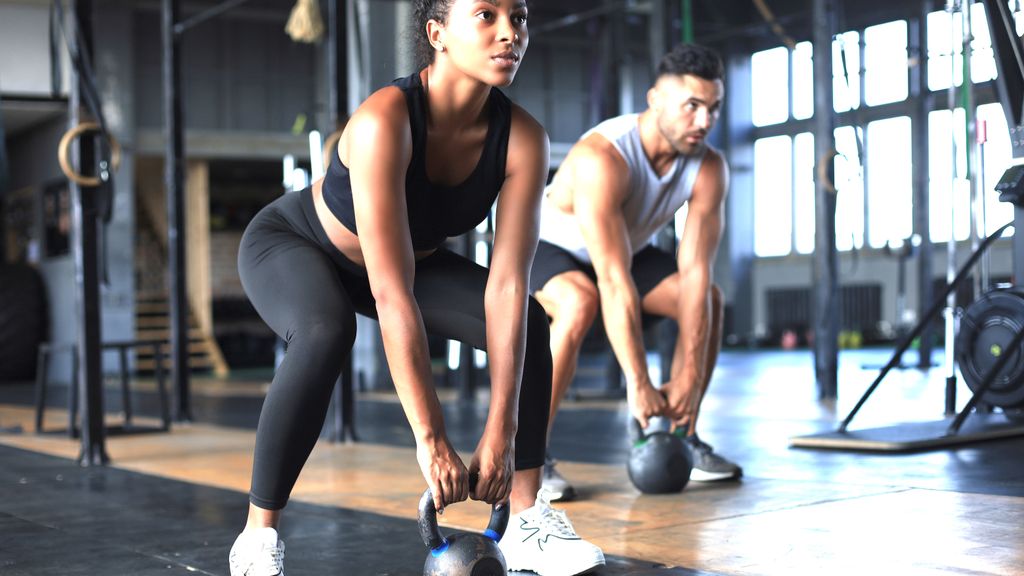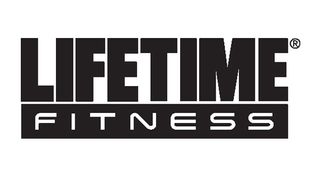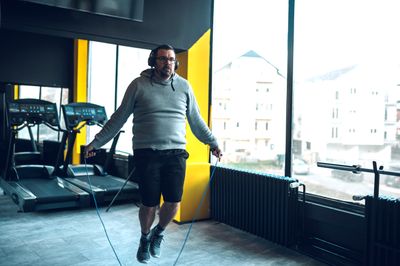
Circuit training is an efficient and effective way to achieve your fitness goals, from building strength to improving cardiovascular health.
If you struggle to exercise consistently because you don’t have a lot of time to dedicate to your workouts, circuit training could be the perfect solution.
Related Circuit Training Resources
If you're interested in circuit training, check out GymBird's related resources for getting started:
- Best Circuit Training Workouts
- How to Do Circuit Training with Weights
- Best Circuit Training Workouts for Athletes
- Best Circuit Training for Runners
- Is Circuit Training Aerobic or Anaerobic?
- Circuit Training vs HIIT
- Circuit Training vs CrossFit
- Circuit Training vs Cross Training
What Is Circuit Training?
Circuit training is a distinct workout structure. It involves cycling through multiple exercises, which allows you to target several muscle groups in one training session.
A simple example of a circuit training workout might look something like this:
- Spend 45 seconds doing squats; rest for 15 seconds
- Move directly into 45 seconds of push-ups; rest for 15 seconds
- Move directly into a 45-second plank hold
- Rest for 60 seconds, then repeat the circuit three more times
You can do circuit training workouts just about anywhere—in the gym with dumbbells or barbells, or at home with dumbbells, resistance bands, or even just your body weight.
Many gyms also offer circuit training classes for those who are interested in this type of exercise but aren’t sure where to start or like to work out in a group.
Personal trainers may use circuit training to help clients get the most out of their sessions as well. Circuits allow the trainer to take their client through more exercises in a shorter period of time, helping them get more value out of working together.
Get our fitness newsletter
Stay on track with your fitness goals and get inspired! Sign up for the GymBird newsletter for twice-monthly expert fitness and nutrition tips.
Circuit Training vs. High-Intensity Interval Training
Some people confuse circuit training with High-Intensity Interval Training (HIIT) workouts. They seem similar at first. However, they’re actually quite different.
According to the National Association of Sports Medicine (NASM), the following are the primary differences between circuit training and HIIT workouts:
- Intensity: HIIT workouts involve performing exercises at 95-100% maximum effort for a short period (30 seconds or less); Circuit workouts involve performing exercises at medium intensity for longer periods (usually over 30 seconds).
- Length of Rest: HIIT workouts often include longer rest periods between exercises compared to circuit workouts (so you can perform each round of exercise at maximum intensity).
- Workout length: HIIT workouts are usually shorter than circuit workouts (because they involve a higher intensity), although both are still very efficient exercise options.
Circuit training can also involve a mix of strength and cardiovascular exercises. On the other hand, HIIT workouts typically focus exclusively on cardiovascular exercises like sprinting on a treadmill or exercise bike.
Benefits of Circuit Training
Circuit training offers many benefits that different types of exercise don’t. Here are some of the top reasons why some people prefer circuit training over other kinds of workouts
Increase Strength
Circuit training workouts often include muscle-strengthening or resistance exercises like push-ups, lunges, squats, and dumbbell overhead presses.
A well-planned circuit training workout—we’ll talk more about planning your workouts later—can efficiently address all the body’s major muscle groups.
When you perform these workouts consistently, you’ll likely notice that you get stronger. As a result, you’ll start lifting heavier weights or performing more reps during each training session.
Plenty of research also backs up the strength-building benefits of circuit training. For example, a meta-analysis (a review of several studies) published by the journal Biology reveals that circuit training with resistance exercises helps adults increase strength and muscle mass in the upper and lower limbs.
Enhance Cardiovascular Health
If you want to incorporate more cardio into your routine but hate the idea of running on a treadmill or riding a stationary bike, you’re in luck. Circuit training is a sufficient alternative. (It might even be superior if it helps you be more consistent with your workouts.)
According to health studies, circuit training can improve cardiovascular health and increase endurance, in addition to strengthening your muscles.
You can easily incorporate more exciting cardiovascular exercises like jumping rope or squat jumps into circuit training sessions. However, you’ll also notice that your heart and breathing rates increase quickly when you perform exercises like push-ups or lunges during circuit workouts.
When you regularly engage in circuit training, you’ll likely find that your cardiovascular endurance improves—without ever pounding the pavement or numbing your tailbone on an exercise bike!
Improve Body Composition
According to UC Davis Health, “body composition” describes a person’s percentage of body fat, bone, and muscle.
A lower body fat percentage—paired with higher muscle mass and bone density—is associated with better long-term health outcomes, including increased insulin sensitivity and a decreased risk of type 2 diabetes.
Combining cardiovascular and strength training exercises, as circuit workouts do, can help you burn calories and lower your body fat percentage while also increasing muscle mass and bone density (resistance training strengthens the bones and protects against osteoporosis).
Save Time
A lack of time is one of the most common excuses people have for not exercising regularly—and it’s a legitimate one.
Whether you’re a full-time student (if so, check out our guide for the best gyms for students) or a working mom of three, your schedule is probably fuller than you’d like. However, the health benefits of regular exercise are too great to ignore.
Circuit training makes it easier for you to fit in a quick full-body workout. Some circuit training sessions can even be completed in under 30 minutes!
Keep in mind that doing full-body circuit workouts can decrease the total number of workouts you have to do per week.
Let’s say you do three full-body circuit workouts per week. That means you’re targeting all your major muscle groups—quads, hamstrings, chest, back, etc.—three times a week while also elevating your heart rate for some cardiovascular exercise.
Even if you only have time to exercise three days per week, circuit training allows you to get the most bang for your workout buck.
Bust Boredom
Some people have difficulty pulling themselves away from their desks to fit in a workout. However, others have the opposite problem—they get bored quickly and struggle to sit still.
Circuit training might be a good fit for you if you’re someone with a short attention span.
Circuit training workouts naturally involve minimal rest periods and encourage you to continue moving. The exercises change consistently, too, which prevents boredom and keeps you on your toes.
Boost Mood
Strength training and cardiovascular exercise—both of which are staples in most circuit workouts—are both associated with improved mood and better mental health.
A study published by JAMA Psychiatry showed that resistance training contributed to improved symptoms in people with depression. It also revealed that those who weren’t depressed were less likely to become depressed when they strength-trained regularly.
Cardiovascular exercise also helps to combat depression, according to this study published by Psychology of Sport and Exercise. And according to numerous studies in Sports Medicine, cardio can reduce feelings of anxiety as well.
Adjust Workouts for Every Level
Circuit training is flexible.
It’s easy to adjust exercises and make them more or less challenging based on your current fitness level.
For example, say you can’t do a traditional push-up with your hands and toes on the floor. You can elevate your hands on a bench or the wall to make the exercise more accessible.
You can also change the amount of time you spend working versus resting.
Those who are new to circuit training might need longer rest periods than those who are more experienced. On the flip side, those who want to challenge themselves can decrease their rest periods or push themselves to perform more reps than they did during the last circuit.
Types of Circuit Training
- Timed Circuit: Timed exercises with timed rest periods
- Staged/Repetition Circuit: Repeating one exercise before moving on
- Competition Circuit: Perform as many repetitions as possible in a set period
- Sport-Specific Circuit: Timed exercises specific to a sport/activity/skill
Types of Circuit Training
Fitness experts divide circuit training workouts into different categories based on several factors, including whether they focus on timing, the number of reps performed, or both.
The more you know about the different types of circuit training, the easier it is to choose the most appropriate style for your needs, goals, and fitness level.
If you’re new to circuit training and aren’t sure how to get started, learning about the different options is an excellent first step. Each type is explained in more detail below to help you select the one that’s right for you.
Timed Circuit
During a timed circuit training workout, you’ll exercise and rest for set time periods. For example, you might perform an exercise for 30 seconds, then rest for 30 seconds.
Sample Timed Circuit Workout
| Exercise | Time | Rest | Sets |
|---|---|---|---|
| Bodyweight squats | 30 seconds | 30 seconds | 4 |
| Push-ups | 30 seconds | 30 seconds | 4 |
| Reverse Lunges | 30 seconds | 30 seconds | 4 |
| Pull-ups | 30 seconds | 30 seconds | 4 |
| Glute Bridges | 30 seconds | 30 seconds | 4 |
| Plank Hold | 30 seconds | 30 seconds | 4 |
For this workout, you’d perform 30 seconds of squats, rest for 30 seconds, then move on to the next exercise—push-ups. Once you finish the last movement—plank hold—you’ll have completed one set. You’ll then repeat the circuit three more times to complete four total sets.
Assuming you stuck to the exercise and rest times outlined in the table above, you could complete this workout in 24 minutes. How’s that for efficiency?
Staged/Repetition Circuit
Staged or repetition circuit training requires you to perform a certain number of reps and then rest for a set period before moving on to the next exercise. For example, you might perform 10 reps and then rest for 60 seconds.
This type of circuit training is popular for group classes. Participants can increase or decrease the number of reps they perform based on their fitness level. However, everyone is still doing the same exercises and gets to feel that they’re part of a community.
Sample Repetition Circuit Workout
| Exercise | Reps | Rest | Sets |
|---|---|---|---|
| Box Step-ups | 10 (each leg) | 1 minute | 3 |
| Push-ups | 10 | 1 minute | 3 |
| Walking Lunges | 10 (each leg) | 1 minute | 3 |
| Pull-ups | As Many Reps as Possible (AMRAP) | 1 minute | 3 |
| Romanian Deadlifts | 10 | 1 minute | 3 |
| Reverse Crunches | 10 | 1 minute | 3 |
Repetition circuit workouts are not as popular as timed circuit workouts because they’re not quite as efficient. Regardless, they’re still viable options for people who want to enjoy a full-body strength and cardiovascular activity.
Competition Circuit
In a competition circuit workout, you’re in competition with yourself.
You try to execute as many reps of an exercise as possible (with good form, of course) in a set period. The goal with each set is to beat the number of reps you performed during the previous one.
Sample Competition Circuit Workout
| Exercise | Reps | Rest | Sets |
|---|---|---|---|
| Dumbbell squats | As Many Reps as Possible (AMRAP) | 30 seconds | 4 |
| Push-ups | As Many Reps as Possible (AMRAP) | 30 seconds | 4 |
| Dumbbell Romanian Deadlifts | As Many Reps as Possible (AMRAP) | 30 seconds | 4 |
| Dumbbell Overhead Presses | As Many Reps as Possible (AMRAP) | 30 seconds | 4 |
| Dumbbell Hip Thrust | As Many Reps as Possible (AMRAP) | 30 seconds | 4 |
| Bent Over Dumbbell Row | As Many Reps as Possible (AMRAP) | 30 seconds | 4 |
| Weighted Situp | As Many Reps as Possible (AMRAP) | 30 seconds | 4 |
While you should strive to beat your record and increase the number of reps performed during each set, remember that exercise quality matters more than quantity.
Don’t let yourself get sloppy on your form to try and bust out more reps—that’s a recipe for an injury!
Sport-Specific Circuit
Sport-specific circuits are often used by athletes who want to improve in a particular sport.
During each circuit, the athlete will perform resistance exercises like push-ups or sport-specific drills like dribbling a basketball. Instead of resting after they’ve finished their last rep, they’ll run for a set distance (for example, 200 meters) and then move on to the next exercise.
Sample Workout
| Exercise | Reps | Sets |
|---|---|---|
| Run 200 meters | N/A | 1 |
| Squat Jumps | 15 | 2 |
| Push-ups | 15 | 2 |
| Run 200 meters | N/A | 2 |
| Bench Dips | 15 | 2 |
| Side Crunches | 15 (each side) | 2 |
| Run 200 meters | N/A | 2 |
You might have noticed that in the table above, all the exercises are performed for 2 sets except the first 200-meter run. That’s not a mistake!
The first and last exercises in this circuit are the same, so if you end with a 200-meter run, you don’t have to turn around and run an additional 200 meters. You can just move on to the next exercise (squat jumps).
Sport-specific circuit workouts are some of the most challenging of all the types of circuit training workouts discussed in this guide. However, they’re meant to help athletes who want to get better at a particular sport or skill.
You might not be ready for this type of circuit workout yet. You might be interested in it in the future, though, when you decide you want to improve your fitness in a specific area.
Creating Your Own Circuit Training Workout
The sample workouts listed above are all great options if you want to dip your toe in the circuit training pool.
Once you familiarize yourself with the different types of circuit training, you can also customize them and create workouts that are tailored to your needs and fitness goals.
If you want to create your own circuit training workouts to do at the gym or at home, use this blank template:
| Exercise | Reps | Rest | Sets |
|---|---|---|---|
How to Get Started with Circuit Training
Perhaps you know the type of circuit training workout you want to do, but you’re still unsure of how to get started. To prepare for your first circuit training session and get the most out of it, be sure to consider these essential factors: workout type, time limit, exercise preferences, rest periods, equipment necessary, and location.
Preferred Workout Type
Start by deciding the type of circuit training workout you want to do.
Are you drawn to timed circuits for their efficiency? Do you prefer competition circuits so you can push yourself to beat your previous records?
There’s no right or wrong answer here. Choose the circuit style that appeals to you the most—and remember that you can always change it up and try something different.
Time Limit
How much time do you have to work out? Do you need to wrap things up in 30 minutes, or do you have more time to dedicate to your training session?
Knowing roughly how much time you want to spend exercising can help you avoid filling your circuit training workout with too many exercises or making your rest periods too long.
Exercise Preferences
What kinds of exercises do you want to do during your circuit training workouts?
Pick exercises that are somewhat challenging and target all major muscle groups. In other words, don’t ignore your legs (or chest or back or shoulders). Strive for overall health and fitness.
Resist the urge to only include exercises that you’re “good” at or that are easy for you, too. After all, you’ll never get better at push-ups if you consistently swap them out for other exercises.
Rest Periods
After you’ve chosen a workout type, established a time limit, and selected the exercises you want to do, you’ll need to decide how long you want your rest periods to be.
Your rest periods should be long enough for you to catch your breath and give your muscles a short break. However, if you rest for too long, you’ll likely find yourself spending more time exercising than you originally wanted. Typical rest periods are usually between 30 seconds and a minute.
Equipment Accessibility
When planning your exercises, consider the equipment you have available and take advantage of your resources.
You can certainly do circuit training workouts with just your body weight, especially if you’re new to the exercises. Push-ups, squats, lunges, burpees, and planks are all great examples of effective bodyweight exercises.
You can also incorporate barbells, dumbbells, and resistance bands into your circuit workouts if you have access to that equipment and you’re comfortable with your form. You could even utilize items you have lying around the house like books, water jugs, soup cans, etc.
Workout Location
Finally, decide where you’re going to do your circuit training workouts.
Will you do them in your living room or backyard with your body weight or items you have at home? Will you go to the gym and do them using dumbbells, barbells, or other equipment
Remember that if you’re doing circuit workouts at the gym, it’s best to limit yourself to just one or two sets of dumbbells. You’ll find that a lot of glares come your way if you hoard five sets of dumbbells to do your circuits—especially if you exercise during peak gym hours!
Best Circuit Training Exercises
Performing a series of exercises back-to-back with minimal rest in between requires careful planning, the right set-up, and the best combination of moves. You’ll also want to choose a variety of exercises that target multiple muscle groups, are pretty easy to perform, and allow for modifications to accommodate different fitness levels and equipment needs.
When designing a routine, try to include both bodyweight and resistance-based exercises, plus compound and isolated movements. For example, a bodyweight squat, dumbbell shoulder press, and biceps curl. And don’t forget about cardio! Aerobic bursts like mountain climbers and jumping jacks increase your heart rate and boost calorie burn. Here are some of the best circuit training exercises that target different muscle groups and provide a balanced full-body workout.
Lower Body Exercises
Squat
Lunge
Deadlift
Stability ball hamstring curl
Glute bridge
Squat jumps
Upper Body Exercises
Push-Ups
Pull-ups
Rows
Shoulder press
Biceps curl
Dips
Core Exercises
Planks
Stability ball crunch
Deadbug
Russian twists
Full-Body/Cardio Exercises
Mountain climbers
Kettlebell swings
Thruster (squat to shoulder press)
Jumping jacks
Best Equipment for Circuit Training
Circuit training is a great way to get a full-body workout in a short amount of time, and having the right equipment can make all the difference. You'll want gear that's easy to use, versatile, and built to last, especially when training at home.
If you train at the gym, equipment shouldn’t be a problem. Some facilities even have areas designed specifically for a circuit style workout, making it easier to move between exercises.
With that in mind, here are some must-haves for a top-notch circuit training setup:
Resistance Bands
Add resistance to exercises like rows, curls, presses, and lateral raises. Resistance bands are color-coded based on resistance.
Dumbbells
Dumbbells are an easy way to incorporate weight into your circuit routine for exercises like dumbbell squats, lunges, bicep curls, and shoulder presses.
Kettlebells
Kettlebells are great for dynamic movements such as kettlebell swings, goblet squats, and Turkish get-ups.
Stability Ball
A stability ball allows you to increase the challenge of performing exercises like crunches, hamstring curls, glute raises, squats, push-ups, and planks. Choose the ball based on your height.
Box or Step
Different heights for box jumps, step-ups, and other lower body exercises that require an elevated surface.
Strength Training Equipment
If you have access to a gym, you can incorporate resistance machines into your circuit routine. Some top picks to try include leg press, hamstring curl, shoulder press, lat pulldown, row, and chest press. You can also use a TRX suspension trainer to do a wide range of bodyweight exercises like pull-ups, squats, chest press, rows, and planks.
Best Gyms for Circuit Training
Most gyms and fitness studios are designed for circuit training. Some may have specialized classes as part of their group exercise programming, while others have a designated circuit training space in the facility.
Orangetheory
Best for Guided Circuit Training
A modified high-intensity interval training (HIIT) gym that uses heart rate monitoring technology to help members maximize their workout and burn calories both during and after their session.
Group classes
Community-focused
Tracked workouts & stats
Some specialty gyms and studios are similar to a circuit training routine, allowing you to move between cardio and resistance-based exercises during a structured, instructor-led workout. Some of these gyms may be available near you:
Check out a gym near you to see their circuit training offerings, which mail include group classes or designated circuit trending areas in the facility:
Life Time Fitness
Best Overall Gym Experience
Life Time is a premier athletic resort that offers a variety of amenities, including fitness equipment, group fitness classes, personal training, spa services, and social events, to help people live a healthy and happy lifestyle, emphasizing luxury and comprehensive wellness offerings.
Premium amenities
On-demand classes
Kids classes
- Life Time Fitness
- Crunch Fitness
- Planet Fitness
- Gold’s Gym
- Anytime Fitness
- 24 Hour Fitness
- LA Fitness
- Equinox
A Word from Ashley
Hi, I'm Ashley Walton, Cofounder and Chief Content Officer at GymBird, and I wanted to add my thoughts to this article.
Personally, I love circuit training. You can pack a lot of different kinds of exercises into one workout routine. I love the variety and how you can target lots of different muscle groups in a short period of time.
Once you understand the basics for how to put together a circuit training workout, I love that it's so versatile. I use circuit training structure for most of my workouts because there are endless possibilities.
In a given week, I'll usually do a few different types of circuit training workouts. One day, I might to circuit training that's high impact with lots of jumps and cardio. Another day, I might focus on my arms with planks, push-ups and weights. And on another day, I might focus on my core with different kinds of crunches. Or I might incorporate all kinds of different target muscle groups into one workout.
I love tailoring my circuit training workouts to my mood and how I'm feeling. If some of my muscles are tired, I can let them rest and focus on others. And I can choose to shorten or lengthen my rest periods and the workout overall to make it more or less challenging. Sometimes I give myself permission to do a really easy, low-impact circuit training workout, knowing it's better than doing no exercise at all.
If you're interested in circuit training, I hope you experiment with it, find workouts that you love, and shape it to your goals and your needs. Most of all, just make sure you listen to your body.
Conclusion
Circuit training is an excellent option for people of all fitness levels and with a wide range of health and wellness goals.
Whether you’re interested in increasing endurance, building muscle, or saving time while enjoying the mental health benefits of exercise, circuit training can help.
Try one of our sample circuit training workouts for your needs or create effective ones of your own from scratch!
You can also check a fitness app that offers circuit training:
Circuit Training FAQs
Is circuit training suitable for beginners?
Absolutely! Circuit training is suitable for all fitness levels, including beginners. That’s because the routines, exercises, and intensity level are easy to modify and adapt to your goals, capabilities, and interests.
However, before starting any new exercise program, especially if you're a beginner or have any pre-existing health conditions, it's important to consult with your doctor or another healthcare professional to ensure that circuit training is safe for you.
Is it necessary to have a trainer for effective circuit training?
While it’s not necessary to have a trainer for effective circuit training, you may want to consider hiring a certified personal trainer or strength coach to help you design a program, teach proper form, and keep you motivated and on track, especially if you’re new to this training style.
One thing to note: If you opt for a circuit training studio, you may be required to work with an instructor who will lead a group circuit class.
Does circuit training help with losing weight?
Cardiovascular and resistance training exercise is a great tool for losing weight and keeping it off. Bonus points if you combine a regular workout routine with a healthy diet!
One reason we like circuit training so much is because it keeps you moving by blending aerobic intervals and resistance exercises, making it a powerful routine to include in your overall weight loss program.
How much weight you can lose with circuit training depends on your goals, daily diet, and other physical activities. In general, a 125-pound person can burn around 240 calories in 30 minutes when engaging in circuit training.





